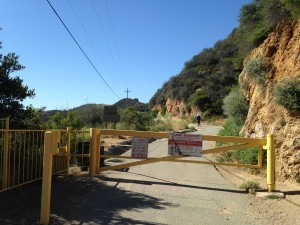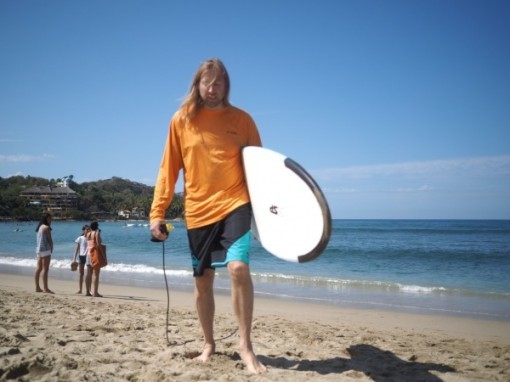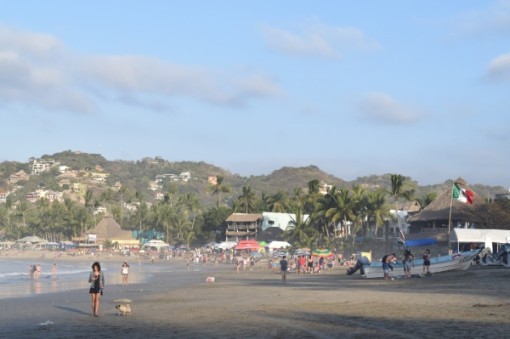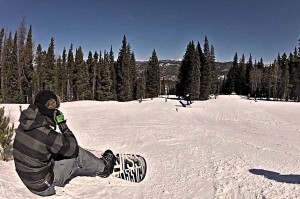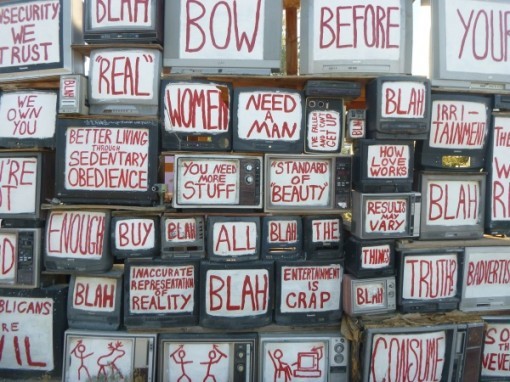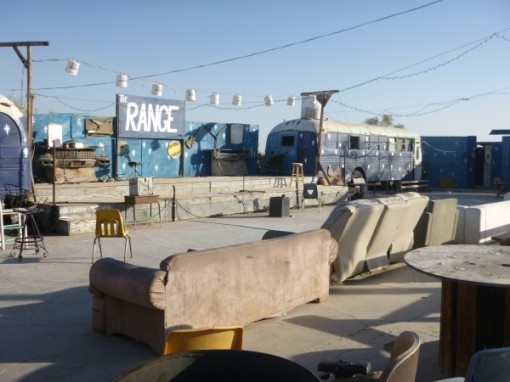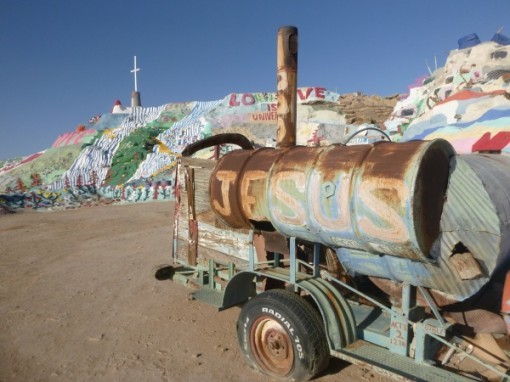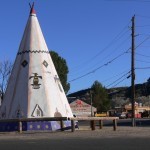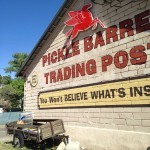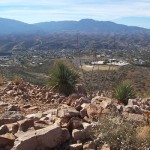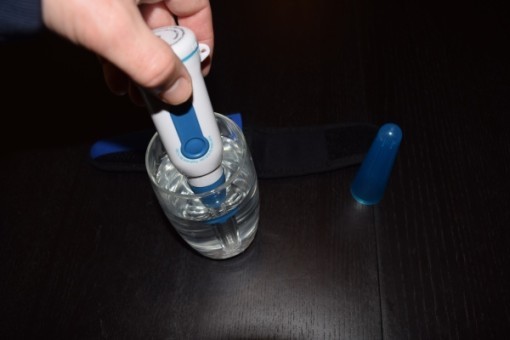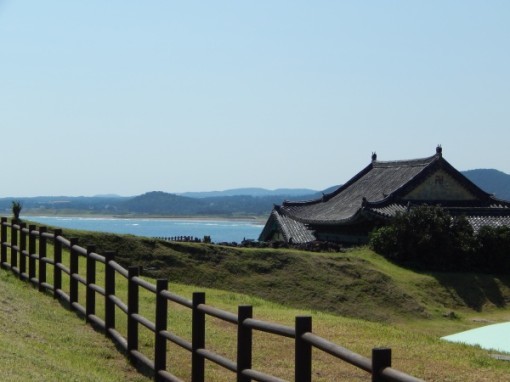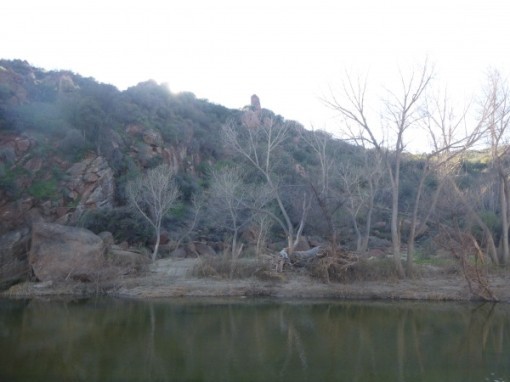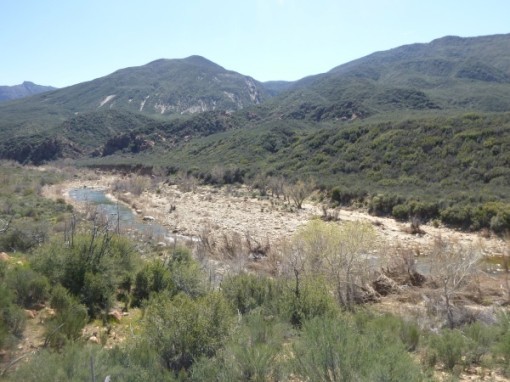Daniel Royse's Blog, page 4
May 14, 2017
How To Get To Murphy Ranch From The Main Trail
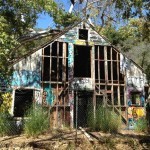 I’ll try to make this quick and easy since I imagine you’re probably on your way to the trail now or desperately searching for the Murphy Ranch since its not always obvious how to find it. In short, you need to descend to the canyon floor from the Sullivan Fire Road Trail but keep reading for more details. Try not to get lost out there, because the Murphy Ranch turns into a labyrinth of small trails once you leave the main trail.
I’ll try to make this quick and easy since I imagine you’re probably on your way to the trail now or desperately searching for the Murphy Ranch since its not always obvious how to find it. In short, you need to descend to the canyon floor from the Sullivan Fire Road Trail but keep reading for more details. Try not to get lost out there, because the Murphy Ranch turns into a labyrinth of small trails once you leave the main trail.
WHAT IS MURPHY RANCH:
Murphy Ranch is an abandoned compound located in Rustic Canyon in the city of Los Angeles. It was built by former Nazi sympathizers in the 1930′s. The facilities were designed to be self-sustaining for long periods of time, however after the bombing of Pearl Harbor in 1941 the property was seized by police and the members detained. It has been abandoned since 1990 and is currently owned by the City of Los Angeles.
For simplicity, just type this address into your GPS. You can find free parking anywhere on these residential streets.
1600 Capri Dr
Pacific Palisades, CA 90272
TRAILHEAD:
The trailhead starts where Casale Rd turns into Sullivan Fire Rd. The road will turn from paved to gravel, but just keep walking. You’ll come to a yellow gate that will be locked. You can just walk around it but no cars can get through. This is the main trail…Sullivan Fire Road!
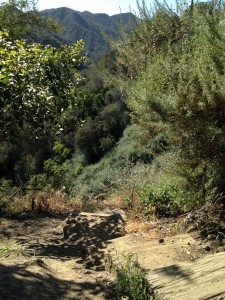 HOW TO REACH MURPHY RANCH FROM THE MAIN TRAIL:
HOW TO REACH MURPHY RANCH FROM THE MAIN TRAIL:
To find the graffiti’ed remains of the Murphy Ranch compound you need to go DOWN. To reach them, there are a few options to descend to the canyon floor.
SIDE TRAIL: As you walk along the main trail, you’ll probably notice a break in the chain-link fence. This is an old stairwell that will take you past the Water Tower and to the canyon floor where the other buildings are.
MAIN FIRE ROAD TRAIL: This will eventually fork into two paths, but you want to stay LEFT and go DOWN. There will be graffiti spray-painted on the road to indicate the way. This is probably the most common and obvious way to get there.
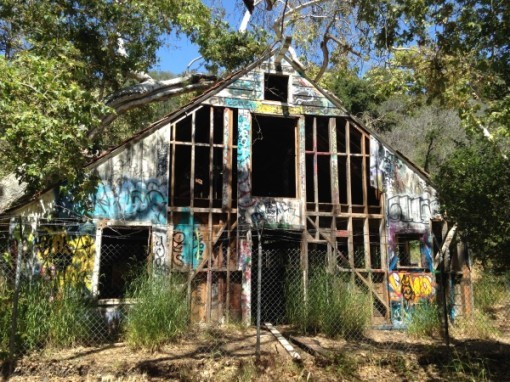 THINGS TO SEE AT MURPHY RANCH:
THINGS TO SEE AT MURPHY RANCH:
When I was there, I noticed four main “sites”…
PowerHouse: This is the MAIN ATTRACTION. The old powerhouse that is still standing with lots of cool graffiti.
Barn: This thing is pretty much ready to collapse and is encircled by a chain link fence. Although there is an opening in the fence that can allow you access, keep in mind it may very well crumble to pieces on top of you. It’s a pretty cool old barn covered in graffiti that is located off the main trail. You need to walk deeper into the canyon to find it.
Gate: This is the original gate to the compound
Water Tower: This is located halfway to the canyon floor…and of course, covered in graffiti.
May 3, 2017
Mexico: Things To See and Do in Sayulita (Mexico’s Surf City)
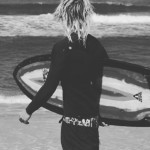 So you haven’t heard of Sayulita? Well, it’s definitely worth checking out if you’re into fish tacos, surfing and chilled out beach bars. It’s not one of your big tourist towns like Cabo, Cancun or Puerto Vallarta and as a result it flies under the radar of mainstream tourism…for now. At the moment Sayulita remains the playground of backpackers, surfers and those who are “in-the-know”. This article can give you the basics on what to expect if you decide to make a visit.
So you haven’t heard of Sayulita? Well, it’s definitely worth checking out if you’re into fish tacos, surfing and chilled out beach bars. It’s not one of your big tourist towns like Cabo, Cancun or Puerto Vallarta and as a result it flies under the radar of mainstream tourism…for now. At the moment Sayulita remains the playground of backpackers, surfers and those who are “in-the-know”. This article can give you the basics on what to expect if you decide to make a visit.
WHAT TO SEE AND DO IN SAYULITA:
Surfing:
By far the biggest draw to Sayulita is the surf. Its great for begginers and experienced surfers as there are two sides to this beach break that luckily seem to cater to each category. The waves break consistently from 1 to 5 feet depending on conditions. I chose to stay on the beginners side of the bay.
Deep Sea Fishing:
Tired of surfing, drinking and laying on the beach? You can hire a deep sea fishing boat to take you fishing around the Marietas Islands for an afternoon. These usually cost a few hundred dollars (USD) to charter, but you can keep the fish if you want. Rather than deal with the hassle we just gave our five large fish to the village. Most fishing boats leave from Punta de Mita.
ATVs:
If you are sick of the coastal life there are also a number of 4-wheel tours that can take you out to the nearby desert. These can all be booked from various travel agencies around Sayulita.
The vast majority of people who arrive in Sayulita will fly into Puerto Vallarta. There are usually cheap flights into Puerto Vallarta International Airport (PVT). From here, you have about a 1 to 2 hour drive north along the coast.
Rental Car:
By far the best way to get to Sayulita is with your own transport. You can get a rental car at any number of places just arcoss from the airport in Puerto Vallarta. Rentals start at about $30 USD per day. Driving in this part of Mexico is pretty easy…not much traffic and similar to the States.
Shuttle:
There are a number of shuttle companies that offer regular transport from Puerto Vallarta to Sayulita. If you are a solo traveler or in a small group try jumping on one of these. The price might be comparable to a rental car but at least you don’t have to worry about accidents and parking.
Bus:
For a couple bucks you can take the public bus up to Sayulita. This option should be reserved for backpackers and folks on a budget. Slow but steady, it’ll get you there…eventually.
FOOD AND DRINK:
Without question Sayulita is known for its fish tacos…and they are very good! Now, I’m in no way a “foodie” but coming from Los Angeles I have had my share of fish tacos and can say that I do approve. If thats not your thing or you’ve gotten tired of fish tacos for breakfast, lunch and dinner there are lots of other options available. Remember this is a backpacker spot so burgers, wraps, sandwiches, pasta, pizza and ice cream are all available.
CRIME:
Yes, I know….Mexico is a scary place these days, or at least it was for a while there. But not to worry, Sayulita is a tourist town. Though it may not be up to the level of its neighbor Puerto Vallarta, its economy is still based on visitors coming into town to eat, drink and surf. You should be fine. BUT like anywhere in the world, check up-to-date local conditions before going.
Sayulita has two seasons. A fairly warm, dry winter and a semi-humid, sometimes wet summer. So yeah, perfect for passing out on the beach all year round. Maybe try to pass out in a light jacket.
WHAT IS SAYULITA LIFE REALLY LIKE?
I want to try and paint a picture for you. Try to imagine a small Mexican town that spreads out along the coast. The sandy beach stretches almost the full distance of the bay with surfing waves perfect for beginners and experts alike. Further back from the sand are a number of beach bars and restaurants while the hills over looking the water are covered with homes and hotels. The downtown area is packed full of restaurants and bars catering mostly to gringos looking to get drunk and fed after a long day of surfing. The important thing to remember is that this town is not big…its small…and gritty. Don’t expect the vibe of Puerto Vallarta here.
Thats all folks…enjoy your Mexican vacation!!
April 11, 2017
How To Get To Breckenridge From Denver (Shuttle Services)
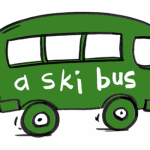 Since there is no commercial airport in Breckenridge, you’ve got to fly into Denver International Airport and then get up to the mountains by ground transport. The trip takes about 1.5 to 2 hours. There are a few options to do this, however the best and cheapest way is still to have your deadbeat friend pick you up from the airport and drive you there. If that’s not an option, check out the remaining modes of transport below.
Since there is no commercial airport in Breckenridge, you’ve got to fly into Denver International Airport and then get up to the mountains by ground transport. The trip takes about 1.5 to 2 hours. There are a few options to do this, however the best and cheapest way is still to have your deadbeat friend pick you up from the airport and drive you there. If that’s not an option, check out the remaining modes of transport below.
RENTAL CAR:
Like any airport, Denver has a plethora of rental cars to pick from…10 to be exact. To reach the rental car agencies, you can take a free shuttle from the Jeppesen Terminal. Shuttles will do pick-up and drop-off at the Jeppesen Terminal on level 5, island 4.
Below is a list of the shuttle companies that make the trip from Denver to Breckenridge. Each one is similarly priced at around $45 to $65 USD. They will typically drop you off at either the Fresno Station or the Breckenridge Station. For an extra fee, you can also request an specific address drop-off point.
Summit Express: www.summitexpress.com
Colorado Mountain Express: www.coloradomountainexpress.com
Peak 1: http://mountainshuttle.hudsonltd.net
TRAIN:
There is no train.
April 8, 2017
Guide To Slab City: How To Get There? Is It Safe? What To See?
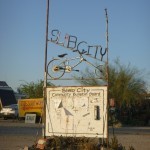 Ever since the movie “Into The Wild” came out Slab City has gained quite a lot of popularity. The movie has put this little corner of the southern California desert on the map and into the minds of a global audience. Although Slab City still keeps much of its original “charm”, its now not uncommon to see tourists wondering about the major “sites” of the area. Despite its rise in popularity its still a unique and fairly wild place. So if you are interested in checking it out, here are some pointers and FAQs that might help you plan your trip.
Ever since the movie “Into The Wild” came out Slab City has gained quite a lot of popularity. The movie has put this little corner of the southern California desert on the map and into the minds of a global audience. Although Slab City still keeps much of its original “charm”, its now not uncommon to see tourists wondering about the major “sites” of the area. Despite its rise in popularity its still a unique and fairly wild place. So if you are interested in checking it out, here are some pointers and FAQs that might help you plan your trip.
WHAT IS SLAB CITY?
Slab City is a community in the Sonoran desert located in Imperial County in southern California located 4 miles east of Niland, CA. It’s known for its eccentric off-the-grid culture and trash-art. It is the remaining concrete slabs of the dismantled and abandoned Marine barracks of Camp Dunlap. The Marine barracks were dismantled in 1956 and given back to the State of California in 1961.
WHO OWNS SLAB CITY?
Slab City is currently owned by the California State Teachers Retirement System. Although no money is generated from this property.
Slab City is an odd mix of RVers, snowbirds, squatters, artists, drunks and druggies. Most of these “slabbers” are retirees that spend the winter months here. There are some permanent residents that can somehow survive the intense heat of the summer months.
WHY DO PEOPLE LIVE IN SLAB CITY?
Good question! Most people in Slab City are retirees or people on disability trying to stretch their government checks. Normally they might travel around the country in an RV and stay in various places that may or may not charge a fee. Although there are many places in the United States where you can park your RV for free (BLM Land), most of them have limits to how long you can stay. Slab City has no limit to how long someone can stay, so it makes a good place for those who don’t want to constantly move. All that someone needs to do is set up camp and have enough food and water to survive.
In recent years people have deliberately moved to Slab City to participate in its unique culture. They come to escape mainstream society and live off the Grid. Many of them come to create art in the middle of the desert.
HOW TO GET TO SLAB CITY:
Start from Niland, CA off Highway 111
Go East on Main Street
Continue on Beal Road about 3 miles
Your first major stop will be Salvation Mountain
Continue past Salvation Mountain
Slab City (where people actually live) is about another 1/2 mile
Yes. In my opinion Slab City is safe. People seem to be friendly and used to seeing visitors. In fact, in recent years Slab City has become something of a tourist attraction. As a result, it has commercialized to some extent. When I was there, the first car I saw parked at Salvation Mountain was a Porsche 911. I saw one resident selling jewelry on the side of the road and even an asian couple taking wedding photos near an Art Car. So yeah, it’s not an undiscovered place anymore.
Despite all that, there have still been reports of people getting robbed or assaulted. There tends to be a lot of drug and alcohol use here. Hey, what else are you gonna do in the middle of the desert? So stay aware of your surroundings and don’t piss anyone off. After all, this is their home.
WHAT TO SEE AND DO IN SLAB CITY:
Salvation Mountain
East Jesus
The Range
Pet Cemetery
Slab City Hostel
Slab City Hot Springs
Garbage…lots of garbage
CAN YOU CAMP IN SLAB CITY?
Yes, camping is free and anyone is allowed to camp for as short or as long as you want. Tents, cars and RVs are all okay to use. You just need to find a spot that is not already taken.
There IS NOT: Water, food, sewage, electricity, trash removal, healthcare or law enforcement. You are off the grid here.
There IS: A number of solar panels in use, an internet cafe, a library and a lot of trash and dirt. But that’s about it.
WHAT TO BRING:
For a simple day trip, you probably don’t need to bring any gifts, food or beverages. But if you are planning on spending the night, it doesn’t hurt to have some beer or whiskey to pass around in order to make friends. Remember you are a guest so you want to be on everyones good side.
In terms of your own survival, you will need food, water shelter, transport and probably shade. It can get hot there!
WHAT NOT TO DO:
Do NOT drive off into the desert. Roads can quickly turn into sand traps
Do NOT leave your trash behind (cigarette butts included), despite what it looks like there
Do NOT come empty handed. You may want items to help make friends
April 5, 2017
Rocky Mountain Snowboard and Ski Terms
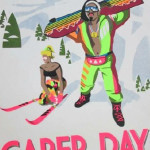 Have you ever taken a trip up to the Rocky Mountains, tried to talk with the locals and not understand what the hell they were talking about? Well I have, and I recently realized that the folks who live up in these small mountain towns of the Rocky Mountains have their own vernacular and terminology when it comes to the snow sports they engage in. Now I can’t guarantee that this list is the “be-all, end-all” of mountain town terminology but its my best attempt at preparing you for some of the strange terms that you’ll most likely encounter in the areas of Breckenridge, Vail, Aspen and Steamboat….basically the Rocky Mountain ski towns.
Have you ever taken a trip up to the Rocky Mountains, tried to talk with the locals and not understand what the hell they were talking about? Well I have, and I recently realized that the folks who live up in these small mountain towns of the Rocky Mountains have their own vernacular and terminology when it comes to the snow sports they engage in. Now I can’t guarantee that this list is the “be-all, end-all” of mountain town terminology but its my best attempt at preparing you for some of the strange terms that you’ll most likely encounter in the areas of Breckenridge, Vail, Aspen and Steamboat….basically the Rocky Mountain ski towns.
Hopefully this list might help you look like less of a dumbass than I did.
FRESH POW: Short for “powder”, it refers to fluffy new snow fall that would resemble powder. Perfect ski and snowboard conditions.
VERT: Short for “Vertical” and used to describe the distance in feet of how high you ascend or decent up or down a mountain.
ROLLING DOWN THE WINDOWS: When you go off a jump and desperately try to stay centered in the air by swinging both arms in frantic circles. Dare I say it, in a motion similar to rolling down a window.
HAVING A YARD SALE: When you wipe out while going down the mountain and your gear flies off in different directions as if you are getting rid of your shit, not unlike having a yard sale.
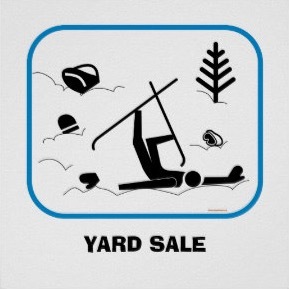 SLED: A mountain man’s term for Snow Mobile.
SLED: A mountain man’s term for Snow Mobile.
DROP A LINE: To determine a line of sight or a pathway down a slope. Usually reserved for backcountry skiing and snowboarding in order to find a clear path between trees.
HOT LAP: When you drive your lazy friends up the mountain in a snow mobile so they can ski or snowboard down.
CANADIAN STYLE: When two people ride on a snow mobile with one person on each side. Each person holds one of the two handle bars.
GAPER: Pronounced “Gay-Per”, it’s a derogatory term for out-of-towners or weekend warriors who suck at skiing and snowboarding. The term comes from the “gap” between their goggles and their hat. The classic image of a Gaper is someone in 1980′s ski attire, usually head-to-toe in bright neon colors.
If you are reading this article then you are probably a Gaper. I know I am.
March 29, 2017
Arizona: Top 5 Things To See and Do in Globe
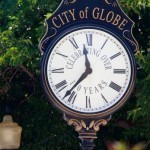 Let’s face it, you’re not traveling across the country just to see Globe, AZ. BUT if you’re in the area its not a bad place to spend a day. You may have heard about its quaint old town feel, its beautiful desert scenery and its pre-Columbian ruins. So if you find yourself in the Phoenix area, take Highway 60 going east and you’ll run right into Globe. Once there, here’s a list of the most interesting things to see and do.
Let’s face it, you’re not traveling across the country just to see Globe, AZ. BUT if you’re in the area its not a bad place to spend a day. You may have heard about its quaint old town feel, its beautiful desert scenery and its pre-Columbian ruins. So if you find yourself in the Phoenix area, take Highway 60 going east and you’ll run right into Globe. Once there, here’s a list of the most interesting things to see and do.
Centered around Broad Street, you’ll know it when you see the small “City of Globe” clock and the medium-sized church. There are also a number of small shops and historic buildings in the area. On the south end of the historic area you’ll see a concrete Teepee that was built in 1940 as a fast food stand, later turned into a salon and now sits vacant.
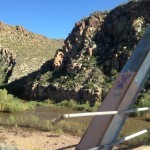 SALT RIVER CANYON SCENIC DRIVE:
SALT RIVER CANYON SCENIC DRIVE:
Slightly north of the Globe and Miami area, you will need to follow Highway 188 north for about 20 miles until you hit Theodore Roosevelt Lake. The Salt River Canyon area is just east of the lake on Globe Young Highway. Its a popular white water rafting area.
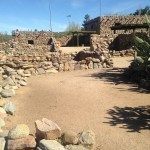 BESH BA GOWAH ARCHAEOLOGICAL SITE:
BESH BA GOWAH ARCHAEOLOGICAL SITE:
The Besh Ba Gowah ruins are the paritally restored pre-columbian settlement of the Salado Pueblo. The site dates back between AD 1225 AD 1400 and is joined to a small park and museum. There is also a small fee to enter the ruins of the Salado Pueblo.
Right next door to Los Robertos Mexican Restaurant, is the Pickle Barrel Trading Post. This place sells everything from antiques to handicrafts to lawn ornaments. It has an interesting mix of Native American and old timey Americana items and a few local food products such as teas, candies and hot sauces.
The Round Mountain Park sits just north of Globe and is a great place for day hikes…as long as you can stand the heat. There are 5 different trails in the park, the longest being only 3 miles long.
March 25, 2017
Gear Review: How Does the SteriPen UV Water Purification System Work?
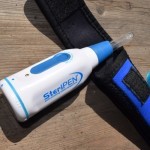 The Steripen is a UV water purification system. It’s a small hand-held device that emits UV rays to purify water by killing bacteria, protozoa and viruses. It takes 4 AA batteries and weighs about 5 ounces. The Steripen UV water purification system is one of the best ways to completely purify water while camping and backpacking…although, its not perfect.
The Steripen is a UV water purification system. It’s a small hand-held device that emits UV rays to purify water by killing bacteria, protozoa and viruses. It takes 4 AA batteries and weighs about 5 ounces. The Steripen UV water purification system is one of the best ways to completely purify water while camping and backpacking…although, its not perfect.
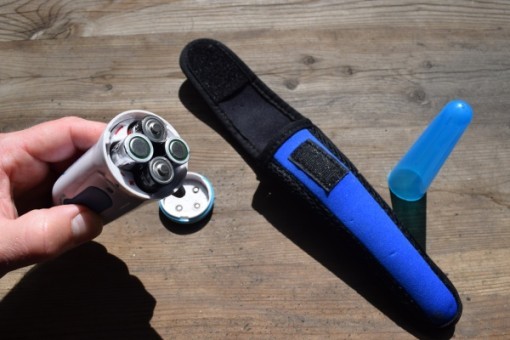 HOW TO USE THE STERIPEN UV WATER PURIFIER:
HOW TO USE THE STERIPEN UV WATER PURIFIER:
The Steripen is probably the easiest and cleanest way to completely purify water. Simply push the button once for 1 liter or twice for 0.5 liters and stir the pen around in your water source. The blue light will emite UV rays that will purify the water of any contaminants.
PROS:
Purifies water fast and without any chemicals
You can use it in any country because it destroys bacteria, protozoa and viruses
CONS:
Needs batteries
Breakable
Adds extra weight to your pack
Does not remove sediment
Overall I love the Steripen! Although it can be little overkill for a lot of situations. If you’re doing a long trek, sometimes its just easier to carry a small bottle of iodine tablets rather than a device of this size (even though it is NOT really that big). But despite Iodine tablets being cheaper and easier to carry, if you don’t mind the device adding weight to your pack, you can have chemical-free water during your trek. Plan on getting weird looks from villages and fellow backpackers whenever you bust it out.
March 22, 2017
Gear Review: Pros and Cons of The Lifestraw Water Filtration System
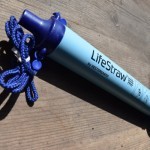 First developed in 2005, the Lifestraw was originally designed to filter out micro organisms from water in sub saharan Africa. It was created as part of an initiative to help the world’s poor get access to clean water. Today Lifestraw-brand products are being used in water projects in over 64 countries. Okay, that’s enough on the company gloating. What can this water filter actually do for you when you’re out camping or trekking?
First developed in 2005, the Lifestraw was originally designed to filter out micro organisms from water in sub saharan Africa. It was created as part of an initiative to help the world’s poor get access to clean water. Today Lifestraw-brand products are being used in water projects in over 64 countries. Okay, that’s enough on the company gloating. What can this water filter actually do for you when you’re out camping or trekking?
WHAT IS THE LIFESTRAW:
The Lifestraw is a water filter in the shape of a large straw that will filter out bacteria, protozoa and other sediment. Like other filters, it will NOT remove viruses. The Lifestraw will let you filter up to 1,000 liters of contaminated water directly from lakes, streams and other sources. It is light and easy to carry with you.
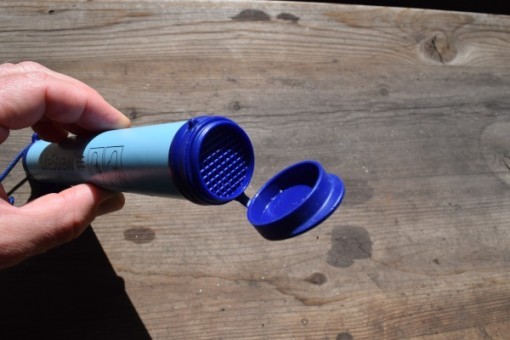 HOW TO USE THE LIFESTRAW WATER FILTRATION SYSTEM:
HOW TO USE THE LIFESTRAW WATER FILTRATION SYSTEM:
To use the Lifestraw simply insert the end of the straw into your water source…and suck! The water will filter as it moves up the straw. Once you’ve finished drinking, blow through the straw to expel any extra water. Easy peezy!
PROS:
Light and easy to transport
Simple to use with no batteries or moving parts
Effective for any backcountry trekking in the USA
Inexpensive
CONS:
Must drink directly from the source, so its not useful for transporting clean water
Does not remove viruses and is not recommended for some less developed countries
REVIEW:
Overall the Lifestraw is a great way to filter water within the United States. However because it does NOT filter out viruses, its not recommended for travel in foreign countries…despite being developed for subsaharan Africa. The biggest issue that I’ve found with this filter is that you have to pull water directly from the source or keep a separate cup with you since the Lifestraw does not fit into any standard plastic bottle. This can be cumbersome when trekking. Otherwise its great. Personally I keep it as a backup because it is so light to carry.
March 17, 2017
Torn between Two Worlds: A Cultural Guide To South Korea
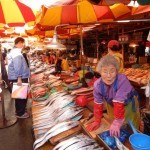 Wandering the color-filled and lively streets of Seoul in late 2014, I find myself in a place that does not really seem to be Korean initially. In one of the fastest growing economies in the world, a lot of cultural changes are taking place, which makes traveling to Seoul a special experience. The Americans, who have been celebrated as the liberators in the Korean War, have left their undeniable mark on the humble nation of South Korea. Having said this, a lot of Koreans are obsessed with Western beauty ideals and consequently, Koreas has the highest rate of cosmetic plastic surgery in the whole world (Eyelid surgery to create a double lid and lengthening the nose are the most popular among the operations). In many ways, Korea is able to demonstrate to the rest of the world, what the future might look like. But as a country with a distinct societal structure and pronounced traditions, they are faced with a number of tensions.
Wandering the color-filled and lively streets of Seoul in late 2014, I find myself in a place that does not really seem to be Korean initially. In one of the fastest growing economies in the world, a lot of cultural changes are taking place, which makes traveling to Seoul a special experience. The Americans, who have been celebrated as the liberators in the Korean War, have left their undeniable mark on the humble nation of South Korea. Having said this, a lot of Koreans are obsessed with Western beauty ideals and consequently, Koreas has the highest rate of cosmetic plastic surgery in the whole world (Eyelid surgery to create a double lid and lengthening the nose are the most popular among the operations). In many ways, Korea is able to demonstrate to the rest of the world, what the future might look like. But as a country with a distinct societal structure and pronounced traditions, they are faced with a number of tensions.
A VAST CULTURAL TRANSFORMATION AND ADAPTATION:
Although South Korea has been officially liberated with the end of the Korea War, they were not as free as they hoped was the case. Having said this, they had to endure an era of military dictatorships and economic hardship until democracy finally arrived towards the end of the 1980s in the midst of culminating student protests all around the nation. Yet, additionally, a very subtle process has been a central influence in Korean society to this day. Being surrounded by the communist North Korea and China in the North and West as well as the disfavored former colonizer Japan in the East, Korean society has always looked up to the Western ideals from America shining bright all the way over the Pacific Ocean. Gigantic malls and office buildings are decorating the city’s skyline, people buy their coffee and breakfast from overpriced chains such as Starbucks and Dunkin Donuts, and they like to spent their Saturday afternoon cheering for their local baseball team. In a lot of ways, Koreas has embraced and absorbed the American way of life.
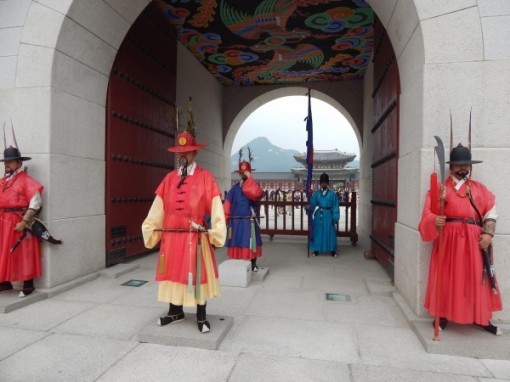 Nevertheless, the more than 50 million Korean people are still clinging on to a number of distinct cultural traditions that make it possible for me to envision a historic Seoul, in which the trade of food was of central importance to people’s lives and they spent their afternoons in teahouse being reluctant to adapt foreign trends. Apart from the numerous spas and special characteristics of the life on well concealed alleys, ancient sites such as the Gyeongbokgung palace or the Bongeunsa temple are still tokens from that period. Because of the on-going tensions, the example of the ajumma/아줌마 (the Korean name for middle-aged or elder women) is particularly suitable to underpin the current situation. These women have been born into an underprivileged world for females and had to dedicate most of their lives to the well-being of their families at home without being necessarily able to pursue their own goals in life. Once their children move out and they get to enjoy a quieter existence, their societal status also increases and like all other older people in Korean society, they are to be treated respectfully. Still, because a lot of young people are outgrowing many innate Korean traditions and identify with the individualistic lifestyle that comes hand in hand with the Americanization, the ajumma feel at a loss and might be coming across as grumpy and ignorant to foreigners.
Nevertheless, the more than 50 million Korean people are still clinging on to a number of distinct cultural traditions that make it possible for me to envision a historic Seoul, in which the trade of food was of central importance to people’s lives and they spent their afternoons in teahouse being reluctant to adapt foreign trends. Apart from the numerous spas and special characteristics of the life on well concealed alleys, ancient sites such as the Gyeongbokgung palace or the Bongeunsa temple are still tokens from that period. Because of the on-going tensions, the example of the ajumma/아줌마 (the Korean name for middle-aged or elder women) is particularly suitable to underpin the current situation. These women have been born into an underprivileged world for females and had to dedicate most of their lives to the well-being of their families at home without being necessarily able to pursue their own goals in life. Once their children move out and they get to enjoy a quieter existence, their societal status also increases and like all other older people in Korean society, they are to be treated respectfully. Still, because a lot of young people are outgrowing many innate Korean traditions and identify with the individualistic lifestyle that comes hand in hand with the Americanization, the ajumma feel at a loss and might be coming across as grumpy and ignorant to foreigners.
Thus, in order to be prepared for the unique cultural experience when traveling through this beautiful country and not coming across as ignorant yourself, you should be aware of such specifics. For your convenience, I have worked on a list of both things you should definitely try out and others that can be considered cultural no-goes.
DOs
DO bring enough deodorant for yourself, as most of the Koreans do not use it and prices are really high
DO try out the enormous range of different Korean foods. Although most of the ingredients are similar, there are many, many varieties of plates to be tried out
DO familiarize yourself with a couple of Korean basics in order to get along in a country, where most of the people do not speak English. In addition, the Korean alphabet may look very confusing at first, but it can actually be learned within only a couple of hours as well
DO ask at your hotel for a Korean version of your address so that you do not have to face an irritating situation in the cab
DO be prepared to eat with chopsticks. Although a spoon is often served for soups, Koreans normally do not eat with fork and knife (the knife is actually often replaced by a pair of scissors to cut the meat at a Korean BBQ)
DO go to a local Noraebang/노래방 (Karaoke bar) and enjoy a nice night with your friends in one of the private rooms
DO take into account that Korea has 4 distinct seasons with a very hot summer and a freezing winter. In my opinion, the country is most beautiful during fall
DO be careful with drinking the tab water. Although it is drinkable in major cities, it might not be such a good idea in the countryside and generally does not taste good
DO try to experience the “real” Korean culture with a temple stay or a visit to one of the many spas (although the big ones are likely to have been Westernized already)
DO bring enough clothes and shoes to Korea if you are oversized and planning to stay longer. You will not be able to find XX-versions easily
DO press that button on your table to call for a waiter and make sure to pay the bill at the register (often located near the exit) instead of asking for it
DO make sure to bargain at a local market, as some people might even be insulted if you do not try to reduce their ridiculous first offer
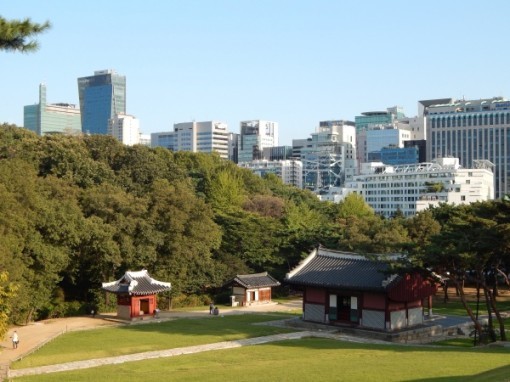 DON’Ts
DON’Ts
DON’T take the black cabs, because they are the expensive ones (a red sign on the front shield of the cab signifies that it is vacant)
DON’T stick your chopsticks upside down in the bowl of rice as it is a very bad sign for Koreans. Just lay it horizontally over the bowl or the plate
DON’T only spend your trip in Seoul, as the countryside and the other cities have so much more to offer and are likely to provide you with a better picture of what Korean culture really looks like
DON’T ask people directly about sensitive topics regarding politics or ideology. Make sure to tackle your questions about North Korea to closer friends or when you get to know each other closer over a bottle of soju
DON’T forget to take off your shoes in a stranger’s apartment or a couple of traditional restaurants, where you will be seated on the floor
DON’T get irritated by all the fancy buttons on your modern toilet. You will most likely not need any of them and you can still find a flush on the toilet itself
DON’T get angry, if people do not understand English. It will just make the situation worse, if you seek a confrontation
DON’T take a seat on the benches at the far ends of every wagon in the subway. They are assigned for the elderly and the sick
DON’T tip at a restaurant or in the cab as it is not a custom in Korea. People will often find it personally insulting to be tipped by foreigners
DON’T drink too much of the Soju. With its light taste, its effects are easily underestimated
DON’T be afraid if the waiter tells you that the food is very spicy. Korean people often think that people from the West cannot handle a bit of spices (please take this only as a general guideline as some of the foods are indeed incredibly hot)
And ultimately, DO NOT under any circumstances miss out on booking your trip to this great country!
March 15, 2017
Los Padres National Forest: How To Get To The Sespe River Trail
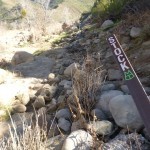 Located on the south side of the Los Padres National Forest is the Sespe River Trail. From the trailhead at Piedra Blanca its a 10 mile hike to Willett Springs where you can swim in the hot springs. If you want to go even further its about another 5 miles to Sespe Hot Springs. This trail follows the Sespe river and is NOT a loop, so you will most likely have to come back the same way. The trail is open all year round but is best during spring and fall. There is also limited cover so summers can be brutal.
Located on the south side of the Los Padres National Forest is the Sespe River Trail. From the trailhead at Piedra Blanca its a 10 mile hike to Willett Springs where you can swim in the hot springs. If you want to go even further its about another 5 miles to Sespe Hot Springs. This trail follows the Sespe river and is NOT a loop, so you will most likely have to come back the same way. The trail is open all year round but is best during spring and fall. There is also limited cover so summers can be brutal.
HOW TO GET TO THE PIEDRA BLANCA TRAILHEAD:
Take Highway 33 North into Los Padres National Forest
Inside the national forest the road tuns into the Maricopa Highway
Go East (take a right) on Forest Rte
At the end of the road is the Piedra Blanca Trailhead
Walk to the east side of the parking lot and take the trail that heads east along the river
WHAT TO BRING:
Adventure Pass: You’ll need this to park overnight at the trailhead
Fire Permit: Just in case you want to use a stove in the backcountry
Water Filter and Bottle: You’ll have plenty of options to get river water as the trail crosses the Sespe River multiple times
Sleeping Bag/Pad/Tent: It can get cold at night…even in summer
Hiking Shoes or Boots: The trail is mostly flat, so you don’t need anything too crazy
Layers: It can get hot during the day and cold at night
Food: No corner stores anywhere nearby
Sunscreen: Yup, its hot
Official Camp Sites: Bear Creek, Oak Flat, Willett, Hartman, Thatcher, Coltrell Flat
Back Country Camping: Along the way you’ll see spots that have been converted into unofficial campsites. These are great places to set up camp.
ANIMALS TO WATCH OUT FOR:
Mountain Lion
Black Bear
Rattlesnake
PIEDRA BLANCA TRAILHEAD TO WILLETT SPRINGS (Round Trip): 20 Miles
PIEDRA BLANCA TRAILHEAD TO SESPE SPRINGS (Round Trip): 31 Miles

